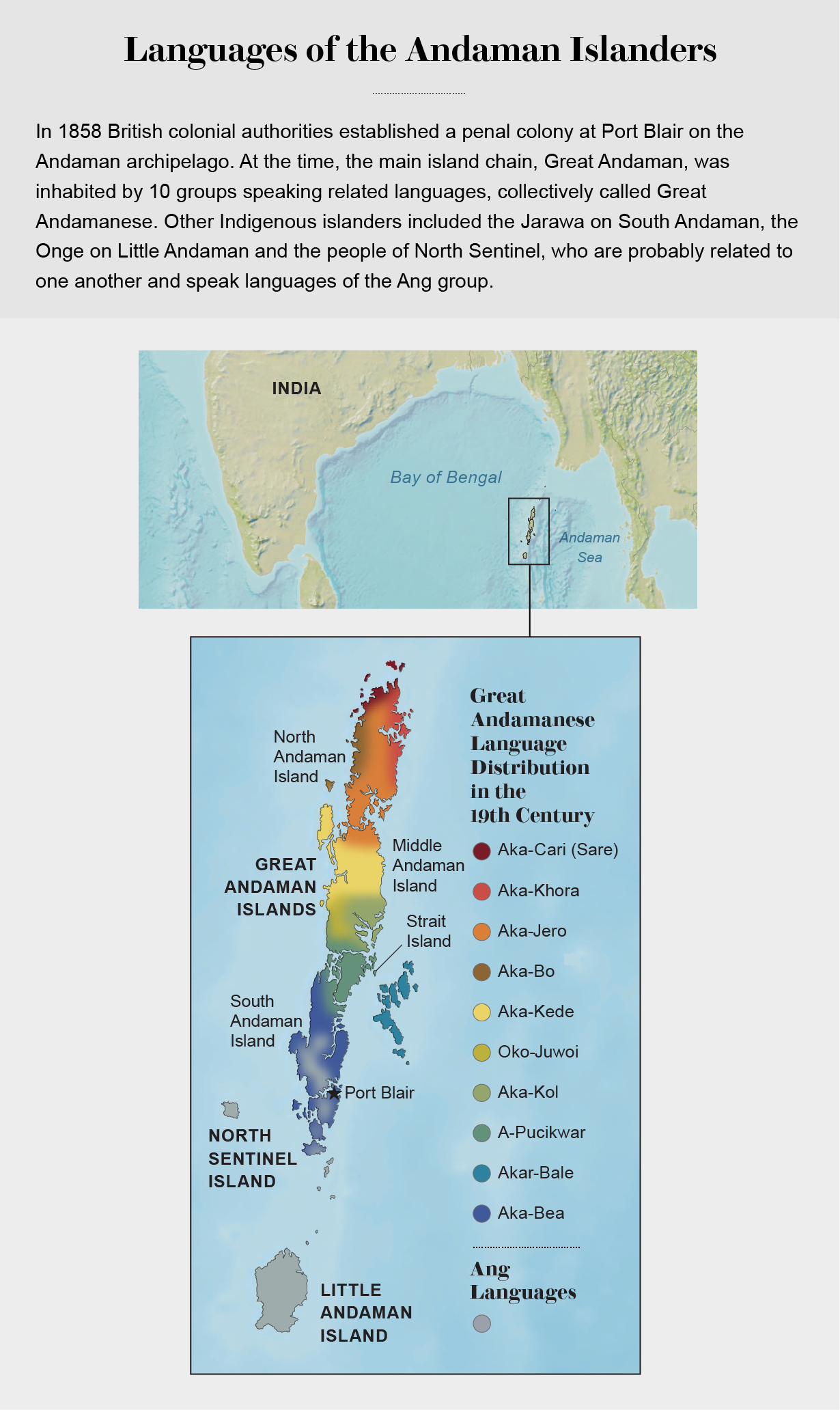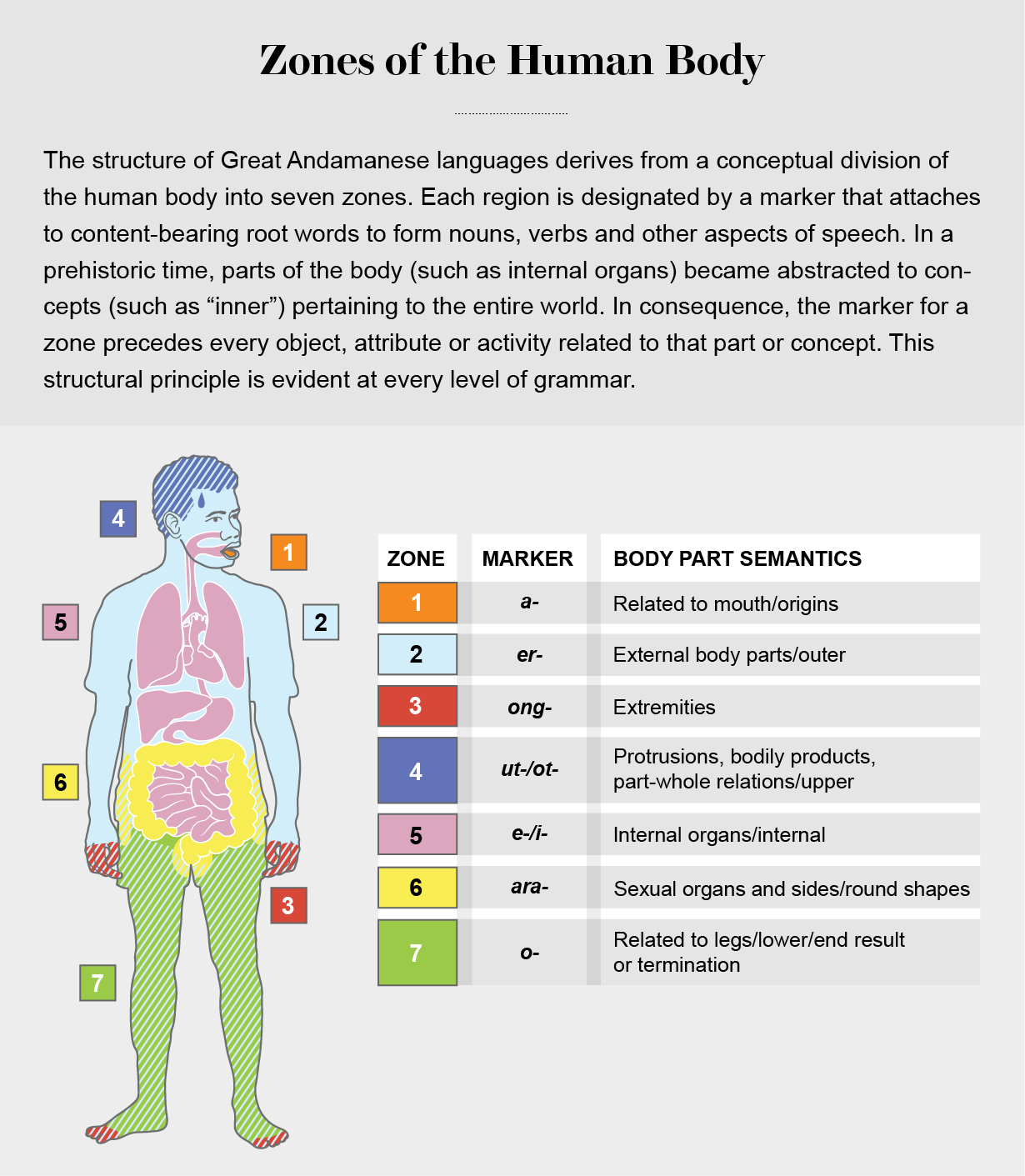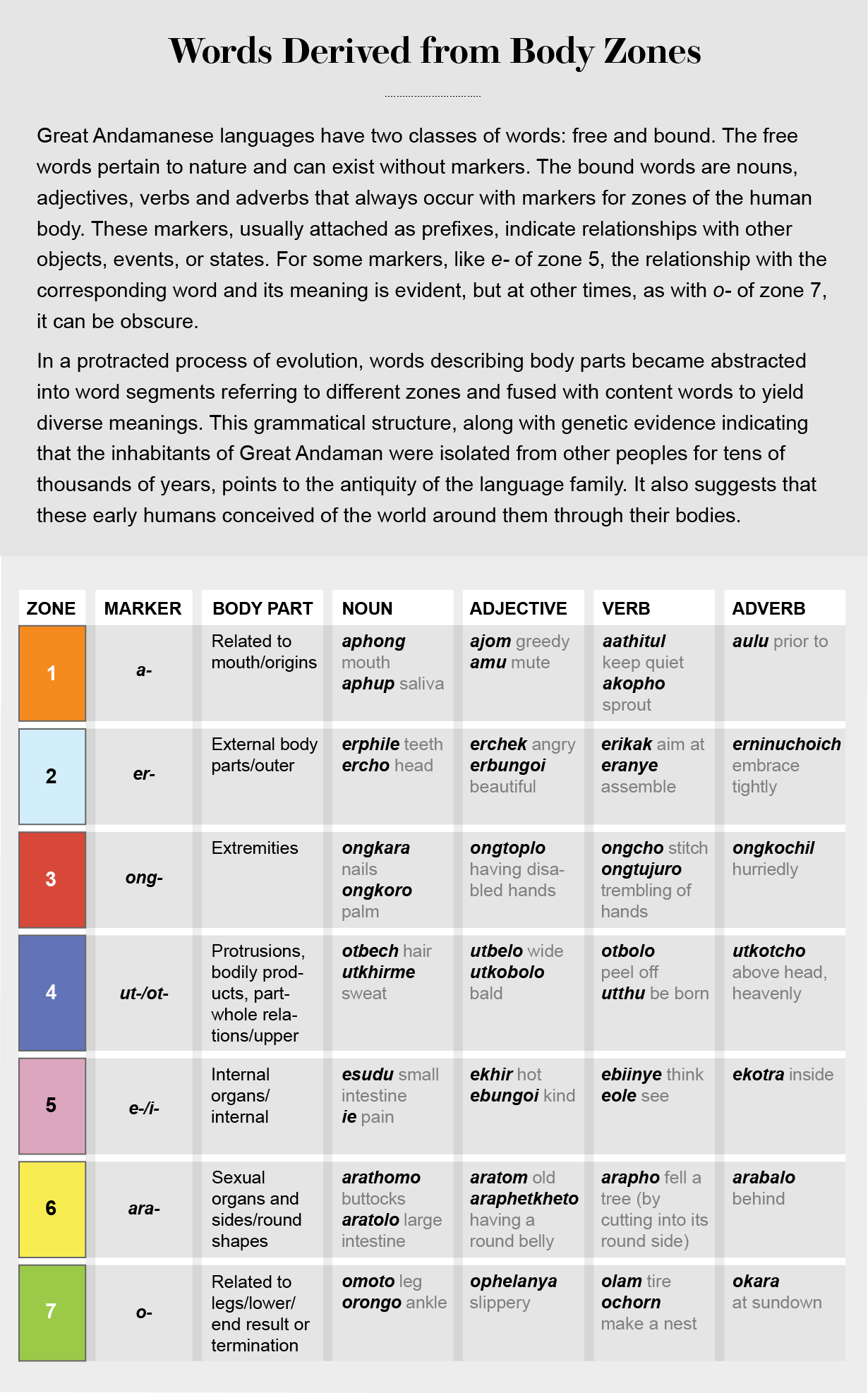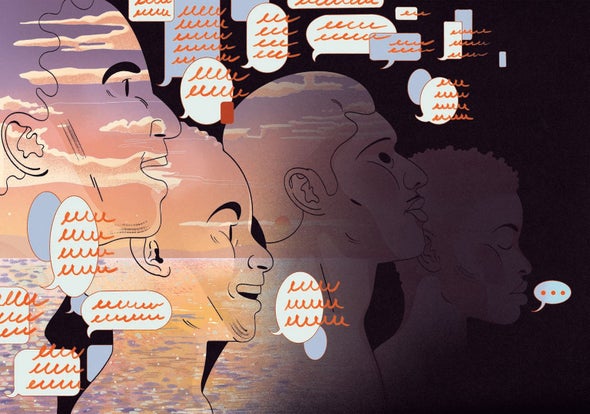One morning in December 2004, elders and children were wandering on the shore of Strait Island in the Bay of Bengal when one of them noticed something odd. The sea level was low, and weird-looking creatures that normally inhabit the deep twilight zone of the ocean were bobbing near the water's surface. “Sare ukkuburuko!”—the sea has turned upside down!—shouted Nao Junior. One of the last inheritors of wisdom transmitted over thousands of generations through his mother tongue, he knew what this bizarre phenomenon signified. So did other Indigenous peoples of the Andaman Islands. They all raced inland and uphill, their ancestral knowledge saving them from the devastating tsunami that slammed onto coastlines across the Indian Ocean minutes later and swept away some 225,000 people.
When I first met Nao Jr., at the turn of the millennium, he was in his 40s and one of only nine members of his Indigenous group, Great Andamanese, who still spoke the idiom of his ancestors; the youngsters preferred Hindi. As a linguist with a passion for decoding structure, I had researched more than 80 Indian languages from five different families: Indo-European (to which Hindi belongs), Dravidian, Austroasiatic, Tibeto-Burman and Tai-Kadai. I was on the islands to document their Indigenous voices before they faded into whispers. What little I heard was so baffling that I returned many times in later years to try to pin down the principles undergirding Great Andamanese languages.
What my main teachers, Nao Jr. and a woman named Licho, spoke was a pastiche of languages that had had some 5,000 speakers in the mid-19th century. The modern vocabulary was highly variable, derived from several languages that were originally spoken on North Andaman. What was truly alien to me, however, was the grammar—it was unlike anything I had ever encountered.
A language embodies a worldview and, like a civilization, changes and grows in layers. Words or phrases that are frequently used morph into ever more abstract and compressed grammatical forms. For instance, the suffix “-ed,” signifying the past tense in modern English, originated in “did” (that is, “did use” became “used”); Old English's in steed and on gemong became “instead” and “among,” respectively. These kinds of transitions make historical linguistics rather like archaeology. Just as an archaeologist carefully excavates a mound to reveal different epochs of a city-state stacked on one another, so can a linguist separate the layers of a language to uncover the stages of its evolution. It would take years of Nao Jr. and Licho patiently enduring my interrogations and fumbles for me to finally learn their language's foundational rule.
Great Andamanese, it turns out, is exceptional among the world's languages in its anthropocentrism. It uses categories derived from the human body to describe abstract concepts such as spatial orientation and relations between objects. To be sure, in English we might say things like “the room faces the bay,” “the chair leg broke” and “she heads the firm.” But in Great Andamanese such descriptions take an extreme form, with morphemes, or meaningful sound segments, that designate different zones of the body getting attached to nouns, verbs, adjectives and adverbs—indeed, to every part of speech—to make diverse meanings. Because no other known language has a grammar based on the human body or shares cognates—words that are similar in meaning and pronunciation, indicating a genealogical connection—with Great Andamanese, the language constitutes its own family.
The most enduring aspect of a language is its structure, which can persist over millennia. My studies indicate that the Great Andamanese were effectively isolated for thousands of years, during which time their languages evolved without discernible influence from other cultures. Genetic research corroborates this view, showing that these Indigenous people descend from one of the first groups of modern humans to migrate out of Africa. Following the coastline of the Indian subcontinent, they reached the Andaman archipelago perhaps 50,000 years ago and have lived there in virtual isolation ever since. The core principles of their languages reveal that these early humans conceptualized the world through their bodies.
Pieces of the Puzzle
When I arrived in 2001 in Port Blair, the region's main town, to conduct a preliminary survey of Indigenous languages, I was directed to Adi Basera, a house that the Indian government allowed the Great Andamanese to use when in town. It was a dilapidated building with peeling paint and dirty rooms; children and adults lounged listlessly in the courtyard. Someone brought out a plastic chair for me. I explained my quest in Hindi.
“Why have you come?” asked Boro Senior, an elderly woman. “We do not remember our language. We neither speak nor understand it.” The entire community conversed primarily in Hindi, it turned out—a language essential for getting by in Indian society and the only one the children learned. As I probed, however, Nao Jr. confessed that he knew Jero, but because he had no one to speak it with, he was forgetting it. Boro Sr. turned out to be the last person to remember Khora, and Licho, then in her late 30s, was the last speaker of Sare, her grandmother's language. When conversing with one another, these individuals used what I call present-day Great Andamanese (PGA), a mixture of Jero, Sare, Bo and Khora—all languages of North Andaman.
When British officials established a penal colony at Port Blair in 1858, the rain forests of Great Andaman—comprising North, Middle and South Andaman, as well as some smaller islands nearby—were inhabited by 10 tribes of hunters and gatherers who seemed culturally related. The people of Great Andaman resisted the invaders, but their bows and arrows were no match for guns and, on one occasion, ship's cannons. Even more lethal were the germs that outsiders brought, to which the islanders had no immunity. In the 1960s, by which time the Andamans belonged to India, there were only 19 Great Andamanese left, living mainly in the forests of North Andaman. Indian authorities settled them on tiny Strait Island.
Another group of hunter-gatherers, the Jarawa, lived on South Andaman, and as the Great Andamanese died out, the Jarawa moved into their vacated territories in Middle Andaman. The Jarawa resisted contact—and attendant germs—until 1998 and now number about 450. Their culture had links to that of the Onge, who lived on Little Andaman and were subdued by the British in the 1880s. Apparently also related to the Jarawa were the people of North Sentinel Island. They continue to live in voluntary isolation, which they enforced in 2018 by slaying an American missionary.

My initial survey established that Great Andamanese languages were unrelated to those of the Jarawa and the Onge, which may constitute their own language family. Realizing that I had to document Great Andamanese before it was silenced, I returned with a team of students in 2005. It was shortly after the tsunami, and the authorities had evacuated all 53 of the Great Andamanese to a relief camp next to Adi Basera. They had survived, but their homes had been inundated and their possessions lost, and a sense of dislocation and grief hung in the air. In this situation, Licho gave birth to a boy named Berebe—a source of some joy. I learned that babies were named while in the womb. No wonder Great Andamanese names were gender-neutral!
At the camp I met octogenarian Boa Senior, the last speaker of Bo and a keeper of many songs. She would become very close to me. Great Andamanese youngsters had responded to mainstream Indians' contempt for Indigenous cultures by turning away from their heritage. Boa Sr. would hold my hand and not let me go because she was convinced that my presence alone, as a rare outsider who valued her language, would motivate the young ones to speak Great Andamanese. Still, I learned it mainly from Nao Jr. and Licho, whose interest in their languages was ignited by mine. Nao Jr., it turned out, knew a great deal about the local environment and Licho about etymology, often being able to tell me which word came from which language. I spent long hours with them at Adi Basera and on Strait Island, accompanying them wherever they went—lounging outside their huts, wandering in the jungle or fishing from the beach. The harder they tried to answer my questions, the more they retrieved from the depths of memory. I ended up collecting more than 150 Great Andamanese names for different fish species and 109 for birds.
British officials had observed that the Andamanese languages were a bit like links in a chain: members of neighboring Great Andaman tribes understood one another, but those speaking languages at opposite ends of the chain, in North and South Andaman, were mutually unintelligible. In 1887 British military administrator Maurice Vidal Portman published a comparative lexicon of four languages, as well as a few sentences with their English translations. And around 1920 Edward Horace Man compiled an exhaustive dictionary of Bea, a South Andaman language. These were significant records, but neither cracked the puzzle the grammar posed.
Nor could I. Somehow my extensive experience with all five Indian language families was no help. One time I asked Nao Jr. to tell me the word for “blood.” He looked at me as if I were an utter fool and did not reply. When I insisted, he said, “Tell me where it is coming from.” I replied, “From nowhere.” Irritated, he repeated, “Where did you see it?” Now I had to make up something, so I said, “On the finger.” The reply came promptly—“ongtei!”—and then he rattled off several words for blood on different parts of the body. If the blood emerged from the feet or legs, it was otei; internal bleeding was etei; and a clot on the skin was ertei. Something as basic as a noun changed form depending on location.
Whenever I got a break from my teaching and other duties, I would visit the Andamans, for weeks or months at a time. It took me a year of concerted study to see the language's pattern—and when I did, all the puzzle's scattered pieces fell into place. Very excited, I wanted to test my made-up sentences right away. I was at the Max Planck Institute for Evolutionary Anthropology in Leipzig, Germany, but I phoned Licho and said to her, “a Joe-engio eole be.” Licho was overwhelmed and gave me a cherished compliment: “You have learned our language, madam!”
My sentence was simply, “Joe sees you.” Joe was a Great Andamanese youth, and -engio was “only you.” My breakthrough was to realize that the prefix e-, which originally derived from an unknown word for an internal body part, had over eons morphed into a grammatical marker signifying any internal attribute, process or activity. So the act of seeing, ole, being an internal activity, had to be eole. The same prefix could be attached to -bungoi, or “beautiful,” to form ebungoi, meaning internally beautiful or kind; to sare, for “sea,” to form esare, or “salty,” an inherent quality; and to the root word -biinye, “thinking,” to yield ebiinye, “to think.”
The Body Code
The grammar I was piecing together was based primarily on Jero, but a look through Portman's and Man's books convinced me that the southern Great Andamanese languages had similar structures. The lexicon consisted of two classes of words: free and bound. The free words were all nouns that referred to the environment and its denizens, such as ra for “pig.” They could occur alone. The bound words were nouns, verbs, adjectives and adverbs that always existed with markers indicating a relation to other objects, events or states. The markers (specifically, a-; er-; ong-; ot-or ut-; e-or i-; ara-; and o-) derived from seven zones of the body and were attached to a root word, usually as a prefix, to describe concepts such as “inside,” “outside,” “upper” and “lower.” For example, the morpheme er-, which qualified most anything having to do with an outer body part, could be stuck to -cho to yield ercho, meaning “head.” A pig's head was thus raercho.

This conceptual dependency did not always indicate physical attachment. For example, if the pig's head were cut off for roasting, the marker t- for an inanimate object would be attached to er- to yield ratercho; it was no longer alive but still a pig's head. The suffix -icho indicated truly separable possessions. For example, Boa-icho julu meant “Boa's clothes.”
Just as a head, a noun, could not conceptually exist on its own, the mode and effect of an action could not be severed from the verb describing the action. Great Andamanese had no words for agriculture or cultivation but a great many for hunting and fishing, mainly with a bow and arrow. Thus, the root word shile, meaning “to aim,” had several versions: utshile, to aim from above (for example, at a fish); arashile, to aim from a distance (as at a pig); and eshile, aiming to pierce.
Also inseparable from their prefixes, which endowed them with meaning, were adjectives and adverbs. For example, the prefix er-, for “external,” yielded the adjective erbungoi, for “beautiful”; the verb eranye, meaning “to assemble”; and the adverb erchek, or “fast.” The prefix ong-, the zone of extremities, provided ongcho, “to stitch,” something one did with fingers, as well as the adverb ongkochil, meaning “hurriedly,” which usually applied to movements involving a hand or foot. Important, too, was the morpheme a-, which referred to the mouth and, more broadly, to origins. It contributed to the nouns aphong, for “mouth,” and Aka-Jero, for “his Jero langauge”; the adjectives ajom, “greedy,” and amu, “mute”; the verbs atekho, “to speak,” and aathitul, “to keep quiet”; and the adverb aulu, “prior to.”
These studies established that the 10 original Great Andamanese languages belonged to a single family. Moreover, that family was unique in having a grammatical system based on the human body at every structural level. A handful of other Indigenous languages, such as Papantla Totonac, spoken in Mexico, and Matsés, spoken in Peru and Brazil, also used terms referring to body parts to form words. But these terms had not morphed into abstract symbols, nor did they spread to every other part of speech.

Most significant, the language family seems to be truly archaic in origin. In a multistage process of evolution, words describing diverse body parts had changed into morphemes referring to different zones and fused with content words to yield meaning. Along with the genetic evidence, which indicates the Great Andamanese lived in isolation for tens of thousands of years, the grammar suggests that the language family originated very early—at a time when human beings conceptualized their world through their bodies. The structure alone provides a glimpse into an ancient worldview in which the macrocosm reflects the microcosm, and everything that is or that happens inextricably connects to everything else.
Ancestors, Birds
One morning on Strait Island, I heard Boa Sr. talking to the birds she was feeding. I listened for quite a while from behind a door and then emerged to ask her why she was speaking to them.
“They're the only ones who understand me,” she replied.
“How come?” I asked.
“Don't you know they're our ancestors?”
I tried to suppress an astonished laugh, but Boa heard me. “Yes, they are our ancestors,” she asserted. “That's why we don't kill or hunt them. You should go ask Nao Jr.; he might know the story.”
Nao did not remember right away, but a few days later he narrated the tale of a boy named Mithe who went fishing. He caught a squid, and while cleaning it on the beach, he was swallowed by a Bol, a big fish. His friends and family came searching for him and realized that a Bol had eaten him. Phatka, the cleverest of the youths, traced the dirty track left by the fish and found the Bol in shallow water with its head in the sand. It was very big, so Phatka, Benge, and others called loudly for Kaulo, the strongest one, who arrived and killed the fish.
Mithe emerged alive, but his limbs were numb. They lit a fire on the beach and warmed him by it, and once he had recovered, they decided to eat the fish. They put it on the fire to roast. But they had neglected to properly clean the fish, and it burst—turning everyone present into birds. From that point on the Great Andamanese had a particular affinity with Mithe, the Andaman Cuckoo Dove; Phatka, the Indian Crow; Benge, the Andaman Serpent Eagle; Kaulo, the White-Bellied Sea Eagle; Celene, the Crab Plover; and other birds they regarded as ancestors.
In the Great Andamanese view of nature, the foremost distinction was between tajio, the living, and eleo, the nonliving. Creatures were tajio-tut-bech, “living beings with feathers”—that is, of the air; tajio-tot chor, “living beings with scales,” or of the water; or tajio-chola, “living beings of the land.” Among the land creatures, there were ishongo, humans and other animals, and tong, plants and trees. These categories, along with multiple attributes of appearance, motion and habits, made for an elaborate system of classification and nomenclature that I documented for birds in particular. Sometimes the etymology of a Great Andamanese name bore a resemblance to the English one. For example, Celene, made up of root words for “crab” and “thorn,” was so named because it cracks and eats crabs with its hard, pointed beak.
The exceedingly detailed understanding of the natural environment held by the Great Andamanese people—Nao Jr. named at least six varieties of seashore and more than 18 kinds of smell—indicates a culture that observed nature with deep love and acute interest. Seeing nature as a whole, they sought to examine the interweaving of forces building up this whole. Space was a cultural construct, defined by the movement of spirits, animals and humans along vertical and horizontal axes. In the worldview of the Great Andamanese, space and all natural elements in it—the sun, the moon, the tide, the winds, the land and the forest—together constituted the cosmos. In this holistic view, birds, other creatures and spirits were all interrelated and integral to the concept of space.
Time, too, was relative, categorized according to natural events such as the blossoming of seasonal flowers, the availability of honey—the honey calendar, one might call it—the movement of the sun and the moon, the direction of winds, the availability of food resources, and the best time for hunting fish or other animals. Thus, when the koroiny auro flower blooms, the turtles and fish are fat; when the bop taulo blooms, the bikhir, liot and bere fish are abundant; when the loto taulo blooms, it is the best time for catching phiku and nyuri fishes; and when the chokhoro taulo blooms, the pigs are at their fattest, and it is the best time to hunt them.
Even “morning” and “evening” were relative, depending on who experienced them. To say, for instance, “I will visit you tomorrow,” one would use ngambikhir, for “your tomorrow.” But in the sentence “I will finish this tomorrow,” the word would be thambikhir, “my tomorrow.” Time depended on the perspective of whoever was involved in the event.
The myths of the Great Andamanese indicated that their earliest ancestors resided in the sky, as in another story Nao Jr. related to me. The first man, emerging from the hollow of a bamboo, found water, tubers, fine clay and resin. He molded a clay pot, lit a fire with the resin, boiled the tubers in the pot and enjoyed a hearty meal. Then he crafted a clay figure and left it over the fire. To his astonishment and joy, it turned into a woman. They had many children and were very happy. After a long time on Earth, the couple departed for a place above the clouds, snapping all ties with this world.
Tears ran down Nao Jr.'s cheeks as he narrated this creation tale, which featured all the elements of life: water, fire, earth, space and air. For this lonely man—his wife had left him years back for another man—creating a partner according to one's wishes was the ultimate romantic fable. When I'd first asked him for stories, he had said he hadn't heard any in 40 years and had none for me. But over many evenings, with crickets chirping and frogs calling outside, he told me 10 precious stories—almost unheard of for a language on the verge of extinction. Perhaps one reason we bonded so much was that we were both raupuch—someone who has lost a sibling. Nao Jr. was shocked to learn that neither English nor any Indian language has such a word. “Why?” he asked. “Don't you love your brothers and sisters?”
Nao Jr. left this world in February 2009. In his untimely death, he took with him a treasure trove of knowledge that can never be resurrected and left me a raupuch all over again. Boro Sr. passed away that November and Boa Sr. in January 2010, leaving her voice in several songs. Licho died in April 2020. At present only three people—Peje, Golat and Noe—speak a language of the Great Andamanese family, in their case Jero. They are all more than 50 years old and suffer from a variety of ailments. The entire language family is at imminent risk of extinction.
Of the roughly 7,000 languages spoken by humans today, half will fall silent by the end of this century. Survival in an era of globalization, urbanization and climate change forces Indigenous communities to replace their traditional ways of life and languages with those of the dominant society. When the older generation can no longer teach the tongue to the younger ones, a language is doomed. And with every language lost, we lose a wealth of knowledge about human existence, perception, nature and survival. To give the last word to Boa Sr.: “All is gone, nothing is left—our jungles, our water, our people, our language. Don't let the language slip away! Keep a hold on it!”


